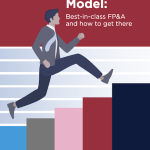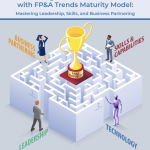The International FP&A Board continues to explore how finance leaders can create a transformation roadmap with the FP&A Trends Maturity Model.

Figure 1: Seattle FP&A Board №10, March 2024
On the 12th of March, 2024, Seattle FP&A Board members gathered to explore the transformative potential of the latest version of the FP&A Trends Maturity Model. 27 senior finance professionals from Microsoft, Amazon, CBRE, VMware, McKinstry, BECU and many other companies convened in the beautiful Redmond Center Regus.
Pigment sponsored this event. Seattle Search Group and IWG, thank you for your tremendous help with the event organization. This article aims to highlight the crucial insights shared during this event and recollect the most important takeaways from this session.
Overcoming Challenges with the FP&A Trends Maturity Model
The meeting started with the participants' introductions, providing their perspectives on the most common challenges FP&A professionals face. At the previous meetings of the International FP&A Board, we identified some of the most significant hurdles that finance departments need to overcome:
- data
- real-time insights
- automation
- standardization/optimization
- lack of organizational alignment
- finding the right systems and tools
- people and skills
- mindset
- speed
- uncertainty
The Seattle FP&A Board members added that competing focus and inadequate self-service analytics could also hinder the FP&A transformation. We should also keep an eye on changing technology trends to stay competitive.
FP&A Trends Maturity Model Can Help You Move to the Next Maturity Stage

Figure 2: The FP&A Trends Maturity Model
The forum eagerly discussed the transformative potential of the latest version of the FP&A Trends Maturity Model. This tool for evaluating where you are on the scale of FP&A maturity was conceived by London FP&A Board members in 2016. Since then, International FP&A Board Members from 32 cities in 18 countries across 4 continents have contributed to its further development.

Figure 3
The FP&A Trends Maturity Model contains 6 dimensions and 5 stages created to help businesses define their level of organizational maturity. There are three "soft" dimensions - leadership, skills and capabilities, and Business Partnering. Three other dimensions are analytical: process, data and analytics, and technology. The audience explored each of them during the meeting, following the insights shared by Larysa Melnychuk, who moderated this event.
Insights from the Field

Figure 4: Alex Erasso shares his insights at the 10th Seattle FP&A Board, March 2024
Alex Erasso, Senior Director Finance at Broadcom (VMWare) and AI/ML Committee Member, was invited to be a speaker and shared his insights on mapping pricing transformation to the FP&A Trends Maturity Model. Alex told the attendees about the standardization of pricing practices and information across functional groups in Cisco and VMware, comparing their phased execution with the FP&A Trends Maturity Model. He briefly outlined the journeys of the companies he worked for and illustrated how the FP&A Trends Maturity Model successfully helped them manage these transformation programmes.
Group Work: Practical Steps for Reaching the Leading Stage of FP&A Maturity
Closer to the end of the meeting, the attendees were split into three groups to discuss how to reach the leading stage of FP&A Maturity. The first group explored the Data & Models aspect, the second focused on Systems and Processes, and the third engaged in a lively discussion about the People and Culture aspect.
Some of the key takeaways from each section are recollected below.
Data & Models
This group stated that we have to start with aligning on language and creating a data dictionary. The next step would be to identify good and bad data sources and clean up the latter. We can get actionable insights and reports only when we have a consolidated model.

Figure 5: Group Work, Seattle FP&A Board №10, March 2024
Systems and Processes
Elevating processes to systems' capabilities and avoiding complexity were deemed crucial factors for undergoing a transformation program. Change Management can help FP&A professionals make incremental progress on their transformative journey.
People and Culture
This group suggested celebrating early wins and establishing regular communication between various teams to ensure the smoothness of the transformation journey. They also underscored the importance of hiring creative people and building multi-faceted teams who understand the business background.
Conclusion and Networking
As the transformative potential of the FP&A Trends Maturity Model was recognized and explored in detail, the meeting ended with networking. The participants enjoyed the opportunity to exchange their thoughts with their peers across different industries and forge newly established connections.







